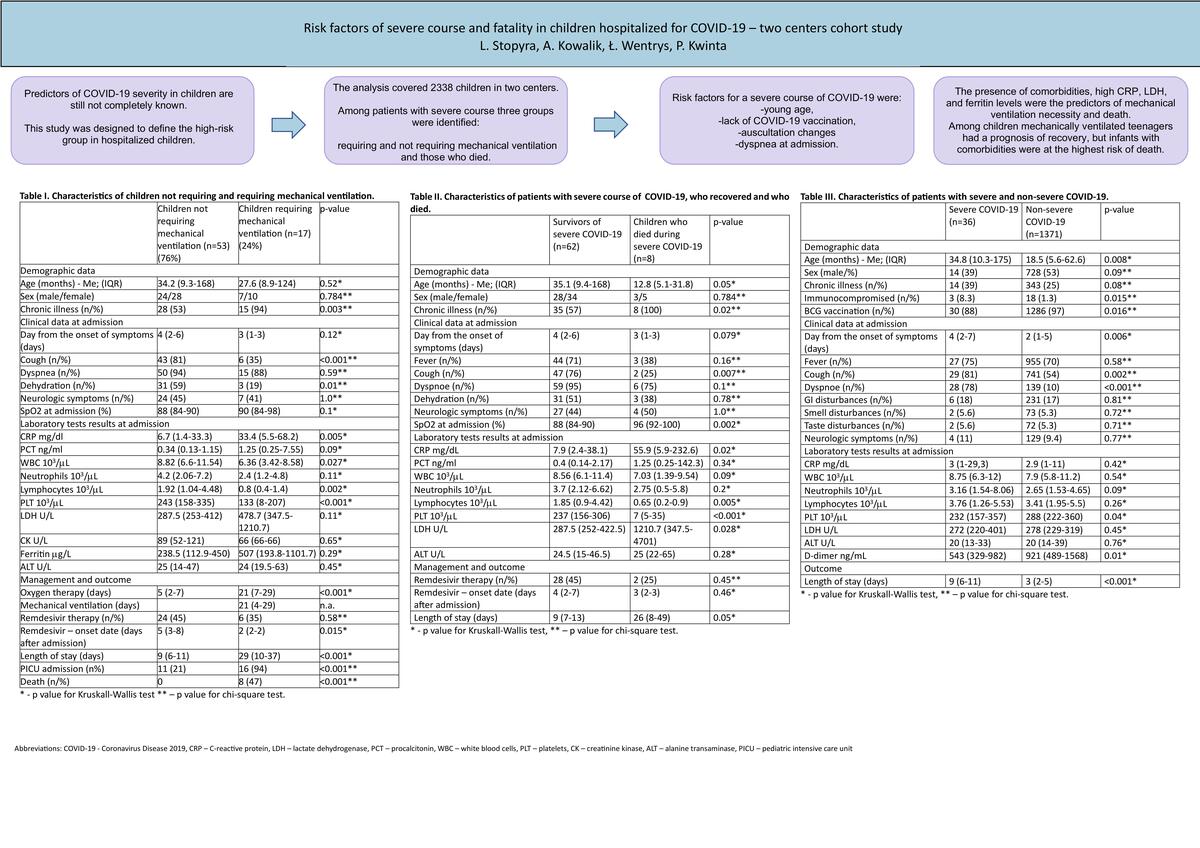Current issue
Archive
Manuscripts accepted
About the Journal
Editorial office
Editorial board
Section Editors
Abstracting and indexing
Subscription
Contact
Ethical standards and procedures
Most read articles
Instructions for authors
Article Processing Charge (APC)
Regulations of paying article processing charge (APC)
INFECTIOUS DISEASES / RESEARCH PAPER
Risk factors of severe course and fatality in children hospitalized for COVID-19 – two centers cohort study.
1
S. Żeromski Specialist Hospital in Krakow, Poland
AFM Krakow University, Poland
2
Department of Pediatrics, Jagiellonian University Medical College., Poland
3
S. Żeromski Specialist Hospital in Krakow, Poland
Submission date: 2023-03-26
Final revision date: 2023-05-05
Acceptance date: 2023-06-03
Online publication date: 2023-06-11
Corresponding author
KEYWORDS
TOPICS
ABSTRACT
Introduction:
After three years of the pandemic, predictors of COVID-19 severity in children are still not completely known. This study was designed to define the high-risk group in hospitalized children.
Material and methods:
The analysis covered 2338 children in two centers. Among patients with severe course three groups were identified –requiring and not requiring mechanical ventilation and those who died.
Results:
The median age of seventy children (54% female) with severe COVID-19 was 32 months. In 43 (61%) children comorbidities were present. No one was vaccinated against COVID-19. On admission, medium SpO2 was 89%. 65 (93%) patients presented with dyspnoea, and 49 (70%) with cough. 53 (76%) children required noninvasive oxygen support and 17 (24%) mechanical ventilation. 8(11%) children died. The most significant difference between mechanically ventilated children who recovered and those who died was age – 124 vs 12.8 months (p<0.001). Children requiring mechanical ventilation presented higher CRP (median 33.4 vs 6.7 mg/dl), LDH, and ferritin. In children who died even higher CRP (55.9 vs 7.9 mg/dl), deep lymphopenia (0.65 vs 1.85 x 103/ul), and thrombocytopenia ( 7 vs 237 x 103/ul) were observed.
Conclusions:
Risk factors for a severe course of COVID-19 were – young age, lack of COVID-19 vaccination, auscultation changes and dyspnea at admission. The presence of comorbidities, high CRP, LDH, and ferritin levels were the predictors of mechanical ventilation necessity and death. Among children mechanically ventilated teenagers had a prognosis of recovery but, infants with comorbidities were at the highest risk of death.
After three years of the pandemic, predictors of COVID-19 severity in children are still not completely known. This study was designed to define the high-risk group in hospitalized children.
Material and methods:
The analysis covered 2338 children in two centers. Among patients with severe course three groups were identified –requiring and not requiring mechanical ventilation and those who died.
Results:
The median age of seventy children (54% female) with severe COVID-19 was 32 months. In 43 (61%) children comorbidities were present. No one was vaccinated against COVID-19. On admission, medium SpO2 was 89%. 65 (93%) patients presented with dyspnoea, and 49 (70%) with cough. 53 (76%) children required noninvasive oxygen support and 17 (24%) mechanical ventilation. 8(11%) children died. The most significant difference between mechanically ventilated children who recovered and those who died was age – 124 vs 12.8 months (p<0.001). Children requiring mechanical ventilation presented higher CRP (median 33.4 vs 6.7 mg/dl), LDH, and ferritin. In children who died even higher CRP (55.9 vs 7.9 mg/dl), deep lymphopenia (0.65 vs 1.85 x 103/ul), and thrombocytopenia ( 7 vs 237 x 103/ul) were observed.
Conclusions:
Risk factors for a severe course of COVID-19 were – young age, lack of COVID-19 vaccination, auscultation changes and dyspnea at admission. The presence of comorbidities, high CRP, LDH, and ferritin levels were the predictors of mechanical ventilation necessity and death. Among children mechanically ventilated teenagers had a prognosis of recovery but, infants with comorbidities were at the highest risk of death.
Share
RELATED ARTICLE
We process personal data collected when visiting the website. The function of obtaining information about users and their behavior is carried out by voluntarily entered information in forms and saving cookies in end devices. Data, including cookies, are used to provide services, improve the user experience and to analyze the traffic in accordance with the Privacy policy. Data are also collected and processed by Google Analytics tool (more).
You can change cookies settings in your browser. Restricted use of cookies in the browser configuration may affect some functionalities of the website.
You can change cookies settings in your browser. Restricted use of cookies in the browser configuration may affect some functionalities of the website.



